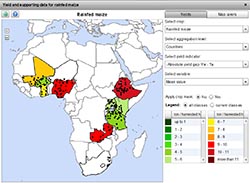Currently sub-Saharan Africa (SSA) is not self-sufficient in cereals, while the demand is projected to triple between 2010 and 2050 due to population growth and changing diets. Therefore it is needed to drastically increase food production to meet this challenging demand for agricultural products by 2050. A major option is narrowing gaps between actual farm yields and yield potential.
Yield potential is the yield with optimal crop growth, i.e. optimal soil management, no nutrient deficiencies, and no yield reductions by weeds, pests and diseases. The difference between the yield which farmers actually obtain and the potential yield is called the yield gap. To reduce yield gaps in SSA, it is needed to substantially increase nutrient inputs on cropland. However, many African countries agreed to contribute to the Paris Climate Agreement, while fertilizers contribute to high greenhouse gas emissions. An opportunity exists in Africa to benefit from cultivating legumes as demonstrated by N2Africa.
|
Within the Global Yield Gap Atlas (GYGA, www.yieldgap.org), the yield gaps for several cereal crops (e.g. maize, sorghum, millet, rice, wheat) in SSA are already determined and mapped (Picture 1). The project ‘Bringing Climate Smart Agriculture to scale: assessing their contributions to narrow nutrient and yield gaps’ builds upon the GYGA project. The project is part of the collaboration between Wageningen University & Research, University of Nebraska-Lincoln and the CGIAR research programme on Climate Change, Agriculture and Food Security (CCAFS), and is also supported by the International Fertilizer Association (IFA) and Yara. The project aims at substantially improving food productivity in SSA (specifically Ethiopia, Kenya, and Tanzania) without corresponding increases in emissions of greenhouse gasses and nutrients to the environment. The addition of the legumes to the Global Yield Gap Atlas is part of the first work package of the project. For Ethiopia we are looking at common bean, chickpea, and faba bean. For Kenya at common bean, cowpea, and pigeon pea. For Tanzania at common bean, chickpea, cowpea, pigeon pea, and groundnut. Within these countries these crops are the main legumes on area basis and are therefore chosen (this is also supported by the N2Africa Baseline Reports I and II). Assessing yield gaps of these legumes could help to provide insight in opportunities to increase productivity of agricultural systems in East Africa with minimum intensity of greenhouse gas emissions. |
Picture 1. Maize yield gap in SSA at country level from the Global Yield Gap Atlas (www.yieldgap.org), black dots indicate the weather stations used for the yield gap assessment |
The yield gaps are estimated based on data collected from weather stations to estimate location specific yield gaps. These are scaled-up to the regional and national level. To do this collaboration with N2Africa agronomists and data on current location specific cropping systems are essential. Therefore, contacts have been established over the past two months between this new project and country agronomists of N2Africa to add the legume yield gaps in Ethiopia, Kenya and Tanzania to the Global Yield Gap Atlas (www.yieldgap.org). Currently, we are working hard to present the first results to you in the next podcaster. By that time we like to present the first results of the Ethiopian chickpea yield gap and the comparison of the common bean yield gap in Ethiopia, Tanzania and Kenya.
Marloes van Loon, Plant Production Systems, Wageningen University & Research

